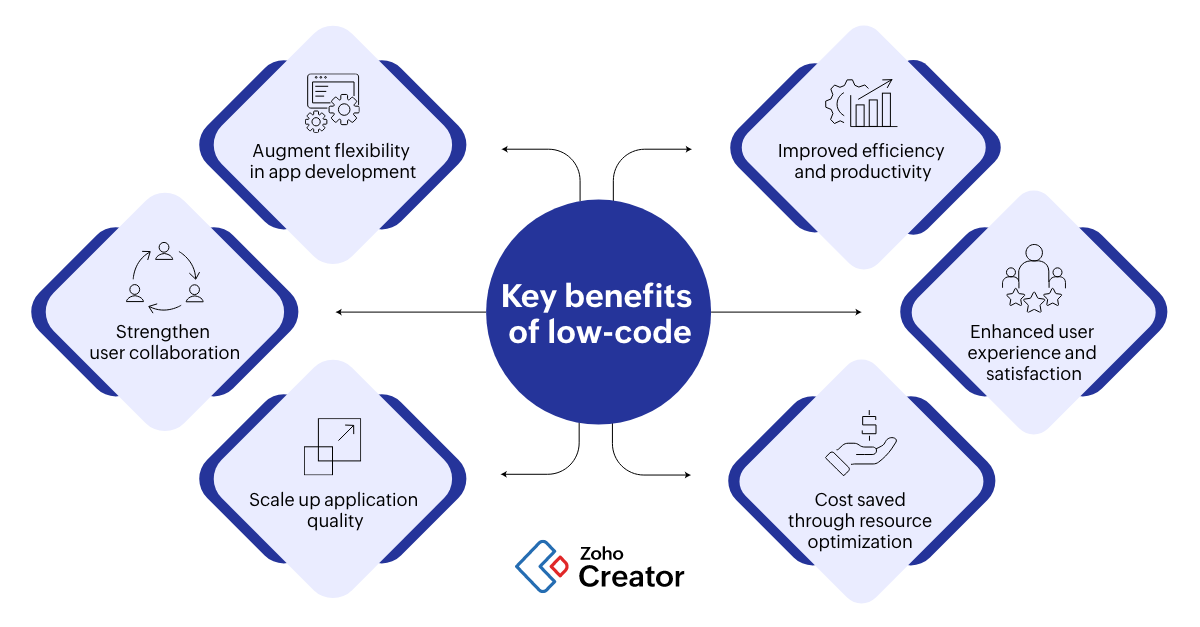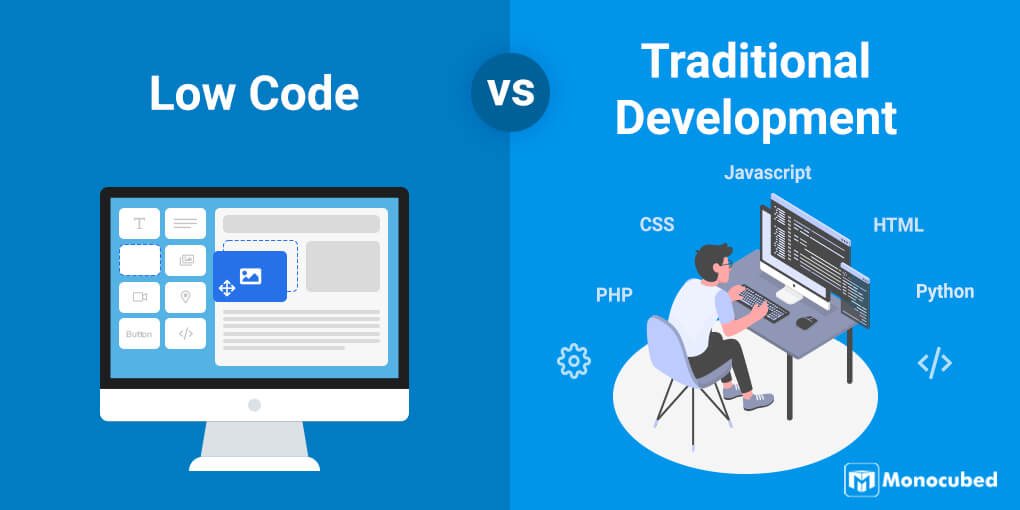Low-code application development significantly improves accessibility for non-developers. Often, they are referred to as "citizen developers" because of a variety of key factors. Intuitive Visual Interfaces:
Drag-and-Drop Builders: Low-code systems feature drag-and-drop interfaces which allow non-developers to build applications without having to write code. This makes development easier for people with backgrounds in technology.
WYSIWYG Editors WYSIWYG Editors "What You saw is what You Get" editors help users create workflows and interfaces that appear as if they were the final products and make them simpler to comprehend.
Simplified Workflow Design and Logic Design
Visual Workflow modeling: Users design business flows and application logic using visual flowcharts. These models are easier to use than traditional method of programming.
Pre-built Logic Components Low-code platforms have logic components that are already built (e.g. conditional statements and loops) that can be easily configured which eliminates the need for complex programming.
Reusable Templates and Components:
Library of Prebuilt Templates: Low-code platforms usually offer templates from libraries for popular application types. This gives non-programmers the possibility of starting with a solid foundation and customize it as required.
Reusable modules and widgets: The creation of websites is made easier by using reusable components and modules. This eliminates the need for deep technical knowledge.
Tutorials for Guided Development and Guided Development
Step-by-Step Instructions Platforms typically offer tutorials on screen, guiding development paths as well as other tools to assist non-developers create applications.
Interactive Tutorials: Interactive and hands-on tutorials allow users to learn through doing. They build confidence using the platform.
Integration of existing tools:
Easy integration: Low-code platforms have been created to be able to seamlessly integrate with existing business systems and tools (e.g. ERP, CRM) permitting non-developers to create applications within their current workflows.
APIs/Connectors: The built-in APIs/connectors make it easy for non-developers connect their applications to external services.
Collaboration Features:
Team Collaboration: Features such as real-time collaboration, as well as shared workspaces enable non-developers to collaborate with professionals, business analysts and other stakeholder groups effectively.
Access Control Based On Roles: Users who do not develop are able to have access to roles and levels of access that allow their participation without compromising functionality or security.
Automated Testing & Debugging
Test Tools Included: Many low-code platforms include integrated debugging and testing tools. These tools automatize the procedure, making it simple for non-developers to ensure their applications are operating properly.
Error highlighting: The platform highlights issues and suggests fixes for non-developers.
The capacity of low-code software to facilitate development for those who are not developers is its main benefit. Platforms with low-code enable business users with intuitive, visual and guided tools. They can then actively take part in the process of developing and maintaining the applications. Take a look at the recommended get more information about Low-code Platform for application development for blog recommendations including app development platform, develop cross platform mobile app, cloud software applications, low code development platforms, low code development platforms, build a docker container, develop web app, build with docker, develop mobile application, rapid app development and more.

Benefits Of Low-Code Applications In Safety And Governance
Low-code development has several benefits in terms of security and governance. They are essential for ensuring applications are secure, reliable and properly managed throughout their lifecycle. These are the major benefits.
Unified management console Low code platforms typically have a central administration console from which administrators can manage all applications and maintain a consistent governance within the company.
Role-Based Access Control RBAC: These platforms come with robust role-based controls that allow administrators to define access policies. Only authorized users will be allowed to modify and access certain areas of the application.
Compliance and Regulatory Adherence
Many low-code platforms come with built-in compliance features. They are designed to ensure that applications comply with industry standards (e.g. GDPR, HIPAA). They offer frameworks and tools to help ensure that applications meet these requirements.
Audit Trails and Logging Complete logging, audit trails and logs are usually integrated into companies, allowing them to track changes and monitor access. They also can make sure that the organization is in compliance with both external and internal laws.
New Security Measures to Improve Security
Data Encryption: Low-code systems generally provide encryption built-in for data in transit and while in transit, making sure that sensitive information is protected.
Security Certificates: A lot of low-code companies have a security certificate (e.g. ISO 27001 and SOC 2) which demonstrate that they are adhering to strict security guidelines. They offer an additional security level to their clients.
Automatic security updates for security:
Regular patches and updates: Low-code platforms handle most security patches and updates automatically. They make sure that applications are protected from the latest attacks without requiring developers to intervene manually.
Security Monitoring: Tools to conduct continuous monitoring of security are provided. They send real-time alerts as well as insights into possible security issues.
Data Governance
Data Access Policies These systems allow organizations to define data access rules and enforce them, ensuring data is available only to authorized users. They also ensure that the data is used correctly.
Data Masking Anonymization The built-in tools for data masking and anonymization features help protect sensitive information, particularly in testing and development environments.
Consistent Application Lifecycle Management
Pipelines for Development and Deployment Low-code platforms typically offer integrated deployment and development pipelines that include security checks, ensuring that security is maintained throughout the entire application lifecycle.
Version Control: The integrated version control helps manage changes and ensures that any changes to the application can be tracked and reverted if necessary, maintaining the integrity of the application.
User Authentication and Authorization:
Single Sign-On (SSO) Single sign-on support and other advanced authentication techniques simplifies user management and enhances security.
Multi-Factor Authentication A lot of platforms come with integrated support for multi-factor authentication. This adds an extra layer of security for applications.
Policy Enforcement Monitoring and Compliance:
Policy Templates: Low-code platforms typically come with pre-defined policy templates which help companies quickly implement governance and security policies.
Compliance Monitoring Tool: These tools provide continuous monitoring, reporting and analysis of compliance status. It's easier to detect potential problems and take proactive steps.
Integration into Existing Security Infrastructure
Seamless Integration: Platforms that use low-code technology are designed to seamlessly integrate with the existing tools and infrastructure such as SIEM (Security Information and Event Management solutions) and firewalls.
API Security: Built-in API security features help protect the data of API users, ensure integrity of applications and provide safe integrations.
Training and best practices:
A lot of platforms provide guidelines and best practices to secure development of applications. They assist non-developers to adhere to security standards.
Certain low-code companies offer security education to help users learn how to develop and maintain secure apps.
The governance and security features of low-code applications make sure that they are developed and maintained in a safe and secure manner. These platforms come with the frameworks and tools needed to secure sensitive data as well as enforce policies and keep regulatory compliance in place, all while simplifying the administration and supervision of the development process. Check out the recommended additional resources for Legacy application modernization with Low-code for website tips including develop web app, ms azure sql, stored sql procedures, cross platform app dev, cross platform app dev, build with docker, low code development platforms, cross platform mobile development, lowcode no code, application development platforms and more.

The Benefits Of Low-Code Development For Developing Applications, In Terms Of Limitations And Customization
Low-code development is an unbiased approach to dealing with the limitations of the system, while also providing for customization. The main advantages are: the limitations
Resolving Complexity:
Simple Development: Low-code platforms cut down on the complexity of development by providing templates and components pre-built for you, enabling rapid development and deployment for complicated applications.
Many platforms have wizards and workflows with guided steps to aid developers in understanding difficult processes. These tools reduce the chances of errors, and ensure consistency.
Scalability Solutions
Scalability is a part of the Low-code platforms often include features that allow for scalable architecture. Applications can handle increasing demands with little redevelopment.
Performance Monitoring: Using tools for performance monitoring optimization, tuning and monitoring assist applications to scale effectively.
Security and Compliance
Integrated security features: Low-code platforms have security measures like encryption, role-based control of access, and automated compliance checking that address security concerns.
Regular Updates: Platforms frequently change their security protocols as well as conformity measures, making sure that applications are protected against new threats.
Customization Options:
Extensibility:
Custom Code Integration : A low-code platforms typically allow for the integration of custom codes (e.g. JavaScript, Python) which enables developers to enhance the capabilities beyond what is available in the standard features.
Custom Plugins and Modules Developers are able to create custom modules or plugins to provide specific features that are adapted to specific business needs.
APIs and integration
API Support: A full API support is provided to allow seamless integration and connectivity to external systems.
Third-Party Platforms: Lowcode platforms are often already built with connectors to third-party applications. This makes it easier to integrate them and personalize the app.
Flexible UX/UI:
Customizable user interfaces: Developers can modify and design user interfaces in order to fulfill specific branding requirements as well as usability needs, providing a tailored experience for users.
Responsive Design: The built-in capabilities of responsive design ensure that applications are able to be tailored to various devices and screen sizes.
Business Logic Customization:
Visual Workflow Builds: Visual tools that allow for the customization of business workflows and rules as well as to design complicated custom procedures.
Conditional Logic & scripting: Platforms can support conditional logic, as well as custom scripting in order to meet specific business rules.
Data Management:
Custom Data Models: Developers are able to develop custom data models that suit specific application needs to ensure that data processing is tailored to business requirements.
Advanced Data Processor: The integration of advanced data processing tools and capabilities allows for the modification of the way data is analysed and used in the application.
How do you balance personalisation and limitations:
Frameworks and Standards
Low-code platforms support the use of industry-standards and best practices, resulting in applications of high-quality that are robust and secure.
Governance Frameworks built-in governance frameworks guarantee that the customizations don't affect the security, integrity or security of the software.
Iterative Development:
Rapid prototyping: The capacity to rapidly prototype and test customizations ensures that developers can modify their designs based on feedback from users improving the app to better meet user needs.
Continuous Improvement: Low-code platforms allow continuous improvement, which allows for constant customization and enhancements as business requirements evolve.
User Empowerment:
Giving Citizen Developers the ability to be empowered: By giving non-developers the opportunity to customize their applications through simple interfaces as well as low-code platforms they increase the number contributors who are able to enhance and customize applications.
Training and Support - A lot of platforms offer comprehensive training and resources to support users in the process of customizing their apps, without impacting the stability or performance of the application.
In general, low-code application development is a strong framework to address issues and offer a wealth of possibilities for customization. This allows businesses to develop and maintain applications that function, are tailored to meet their needs, and that meet high standards of quality, security, and scaleability.
